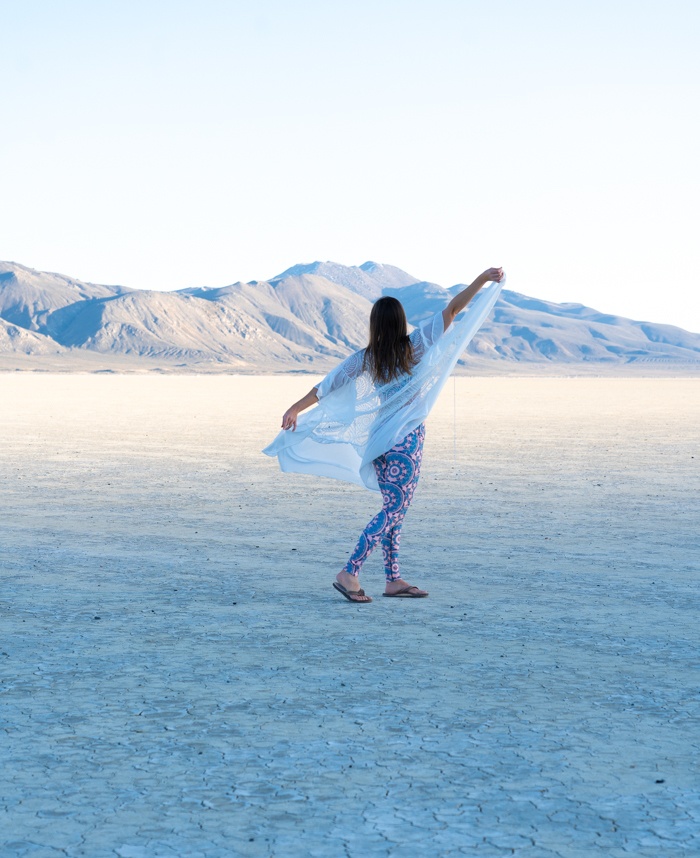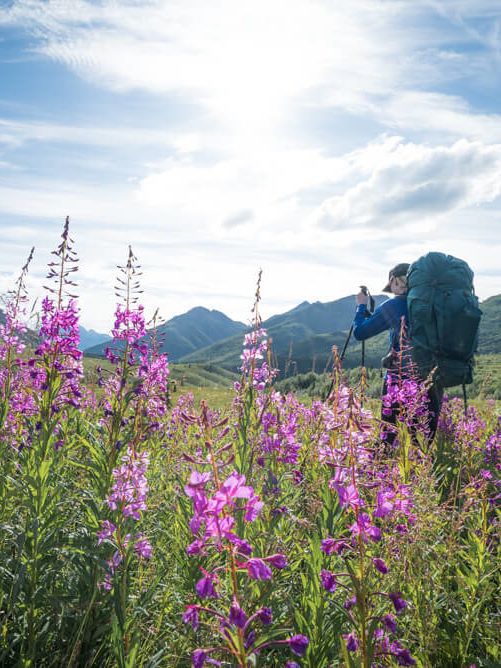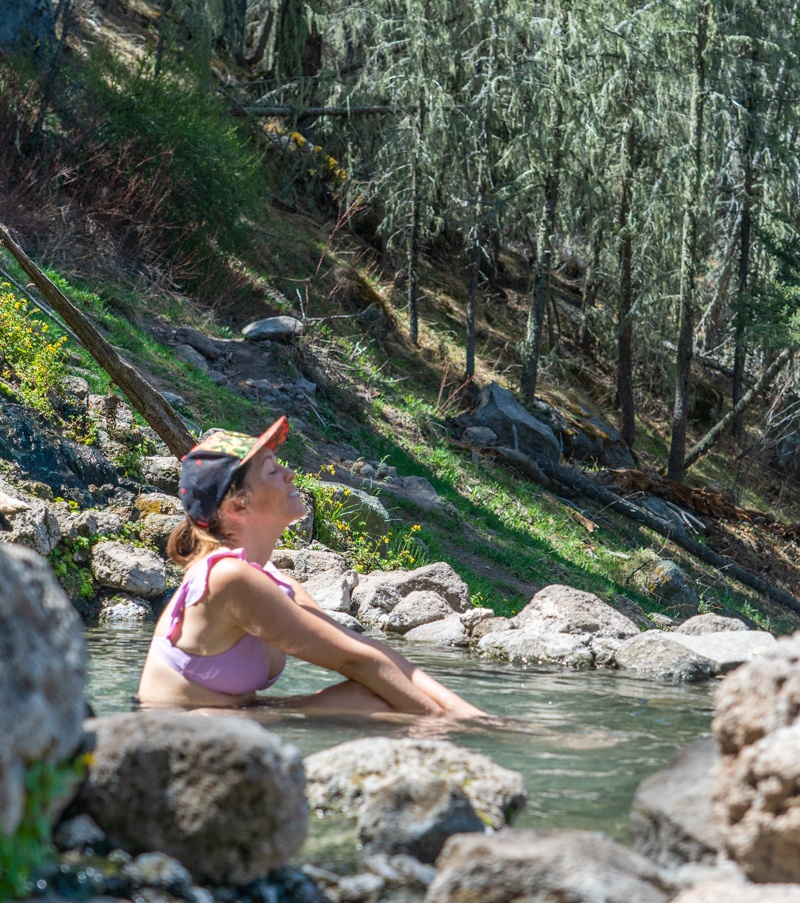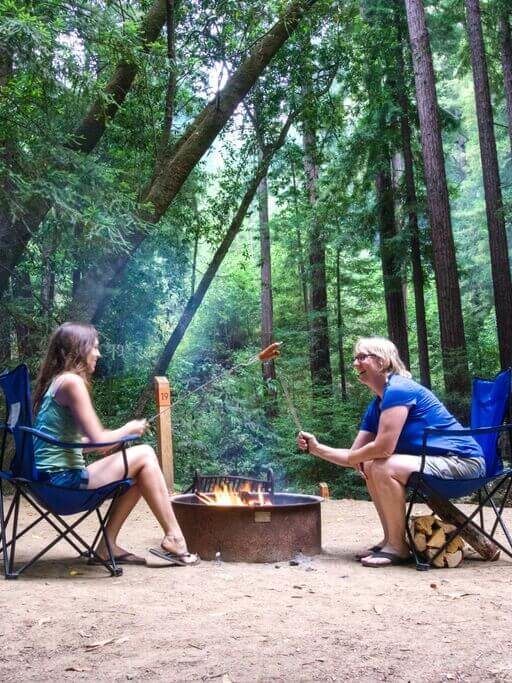Over the years I’ve learned that camping is so much more than just pitching a tent in the wilderness and calling it a night. With a little bit of intention and some pro tips, it’s totally possible to make your camping trip everything you hope it will be. Who knows? You might even find it to be more comfortable and luxurious than a fancy hotel stay!
Here are some genius camping ideas to inspire your next big outdoors trip:
Ask the Important Questions

Before you get knee-deep in your trip planning, there are a few questions that are important to ask yourself. The success of your trip depends on how well you know yourself as a camper and your specific needs:
Why camp?
The way we travel varies greatly from person to person. Some travelers seek luxury in chic hotels, and some are drawn to more rugged backpacking. I tend to lean toward the latter. Here’s why:
- Best access to nature: Whether you’re more of a glamping type or a bare-bones camper, camping is the absolute best way to connect with nature.
- A more customizable experience: Camping allows for much more freedom to choose exactly where you want to stay for the night and what kind of vibe you’re looking for. There are different types of campsites, ranging from your typical family-friendly, fully-equipped ones — with restaurants, swimming pools, and bathrooms — to remote sites with very few amenities.
- It’s affordable: Camping is loads cheaper than staying in a hotel or Airbnb. With some preparation, you might even feel like your camping trip is more comfortable and luxurious than a wildcard hotel stay.
- You’ll learn new skills: During your camping adventure, you’re sure to learn a new skill or two. From pitching a tent to cooking with the bare essentials, the challenges of camping provide plenty of opportunities to learn.
- It’s good for you!: There are few things in life that are better for our mental, emotional, and spiritual well-being than connecting with nature.
Where to camp?
Choosing a place to camp is just as important as having the right tent or packing enough food. These are the most important things to consider when choosing a campsite:
- Choose your site in advance: Whether you’re backpacking in the wilderness or car camping, make sure to plan out where you’ll be camping ahead of time. Some sites require reservations. And it’s also important to know the ins and outs of where you’ll be setting up for the night.
- Know the campsite rules: Choosing the best campsite means being in the know about the specific rules of that site. For example, some sites have noise curfews or no-burn ordinances. It’s important to know these kinds of things before you decide where to camp.
- Know where your water is: You’ll need access to water for a variety of things, such as cooking and bathing. Choose a site that has access to water if you’re not able to bring enough with you. That said, you should also make sure your tent is pitched at least 200 feet away, in order to give wildlife an unobstructed path to the water’s edge.
- Don’t disturb the flora: Make sure to choose a spot that doesn’t trample the flora underneath. Try to find an area that has bare earth or a smooth rock surface to pitch your tent. Pitching on top of plants can damage them, which takes years to reverse.
When to camp?
Often campers assume that the only viable time is during the summer. However, it is possible to camp during any season, depending on the weather conditions at your destination. Here are some things to keep in mind when deciding:
- Rain: If you’re camping in the spring, you’re obviously more likely to encounter rain during your trip. Be prepared to waterproof your shelter, and have a backup plan for your outdoor activities in case you get rained out.
- The climate: Colder climates are most comfortable during the warmer months, but hot climates are best suited for camping in the colder months. In Death Valley, for example, it is best to camp in October or November, when daytime temperatures peak at 90 degrees, but nighttime temps typically stay above 60.
- Crowds: If you decide to camp during peak season, consider that there may be many other people at your chosen site. If this is something you definitely want to avoid, try to plan your trip either before or after peak season, when there are fewer campers.
- Activities: Make a list of the activities you want to partake in during your camping trip. From there, decide which season is best suited for those activities. For example, if you want to take a swim, camping along a lake is great in the summer, but it wouldn’t be as ideal in the wintertime, when the water is too cold for that activity.
-READ NEXT-
Entertainment

Let’s face it, nobody wants to get stuck inside their tent on a rainy day with nothing to do but stare at the wall. Having an arsenal of entertainment is essential in case your outdoor activities fall through, or if you’re a little restless, like I am, and like to always have something to do or listen to:
- Rainy day Netflix-and-chill: Not sure what to do if it rains? The Netflix app allows users to download movies and series to watch offline. Download your favorite media onto your smartphone or tablet before you leave for your trip. That way if the weather is keeping you indoors, you’ll have some entertainment ready to go.
- Download your playlist beforehand: You might not have access to your perfectly curated playlists if you end up camping somewhere without Wi-fi or a phone signal. Download your music onto your device before you leave, so it’s ready to queue up when you need it.
- Podcasts and audiobooks: I personally enjoy listening to podcasts and audiobooks while I hike. To stay alert and also hear the nature around me, I’ll pop just one earbud in and listen to something educational or nature-focused. Download these, too, beforehand. For audiobooks, I use the Libby app, which connects you to your local library using a library card.
-READ NEXT-
Bathroom Tips & Tricks

I don’t know about you, but I always have a plan when it comes to bathroom things. After all, I was a Peace Corps volunteer in southern Africa, and I learned how to prepare myself for all kinds of bathroom challenges. Here are few tips that are more camping oriented:
- Bring a mini medicine arsenal: Store any over-the-counter meds you might need in a pillbox. This way you won’t have to bring each container for things like Advil or allergy meds.
- No toilet? No problem: If digging a hole in the wilderness is as out of the question as an actual bathroom, you can create a makeshift toilet and bring it along with you. You’ll need to line a five-gallon bucket with a heavy-duty trash bag. Then, have sand or kitty litter on hand to sprinkle in the “toilet” after you go number two.
- Protect your TP: To protect your toilet paper from potential falls in the mud, use an old coffee container. Cut a slit on the side where the TP can be pulled out and attach a string to the top to hang it in the bathroom (or on a tree) for easy access.
- Wipes are your friend: If you won’t have access to enough water to bathe, bring some wipes along. These can help you freshen up and at least feel a bit cleaner. Try to find wipes that are biodegradable; if they’re not, make sure not to leave them behind when departing.
Best Camping Recipes

Having a supply of food and some fun recipes is a great way to level up your camping game. Impress your friends with these delicious camping recipes:
Orange Peel Cinnamon Rolls
Did you know that you can make cinnamon rolls over a campfire? Yep, you read that right! Here’s how:
You’ll need:
- Oranges: 1 orange for every 2 cinnamon rolls you want to make. Serve the slices on the side and save the peels to cook the cinnamon rolls with.
- Premade cinnamon roll dough: The tubes of dough work the best.
- Aluminum foil: This is an essential item for most campfire recipes, so make sure you have plenty!
- A surface: This can be a frying pan or cookie sheet — any surface that you can place over your campfire.
- Campfire: Obviously, this is the most essential.
How to make them:
- Cut the oranges in half and carefully take out the fruit, leaving both halves of the peels intact.
- Pop open your cinnamon roll dough tube and place each roll in one of the orange peel halves.
- Wrap the rolls individually with aluminum foil and place on your cooking surface.
- Cook over the fire, checking for doneness every 10 minutes or so.
- Unwrap and enjoy!
No-Skillet Omelets
In case you want to ditch your skillet or just forgot to bring it along, here’s an easy way to make a delicious omelet in a saucepan:
You’ll need:
- A saucepan: You’ll need one big enough to fill with 4-6 quarts of water.
- A bag: You can use a ziplock bag. Or a silicone bag that is heat-safe is great if you’re trying to reduce waste.
- Eggs: 2 per omelet
- Add-ins: You can customize this to fit your tastes. Add cheese, veggies, or meat if that’s your thing.
- Spices: Salt and pepper are classic, but also a dash of paprika or parsley is nice.
How to make them:
- Boil water in your saucepan.
- Add 2 eggs plus your add-ins and spices to your bag.
- Seal the bag and place in the boiling water.
- Remove the bag carefully once the egg has set.
- Roll the omelet out onto a plate and enjoy!

Walking Tacos
This is a classic on-the-go recipe that adapts perfectly to camping. It can be changed up according to your taste preferences and dietary needs, but this is the gist of how it’s done:
You’ll need:
- Chips: Usually these are made using smaller bags of Doritos or Fritos. However, you can make it low-waste simply by separating out portions of a larger bag of Doritos, Fritos, or any corn chip into bowls.
- Protein: Traditionally, these are made with seasoned ground beef. If that’s your thing, go for it. You can also make taco-seasoned tofu or mushrooms.
- Veggies: Lettuce, onion, cilantro, and tomato are staples. If you want more variety, add whatever veggie(s) you have. Bring along some limes to squeeze on top as well.
- Cheese: Cheese and sour cream might not be great to bring on a camping trip, but if you have access to refrigeration, these make great additions.
- Salsa: Don’t forget to bring your favorite salsa to add to your Walking Taco — or to anything, for that matter.
How to make them:
- Prepare your protein: Whether it’s ground beef, ground turkey, tofu, or mushrooms, the directions are basically the same: Heat oil in your skillet, toss in your protein with taco seasoning, and cook until done. Taco seasoning packets are a great idea to bring along, but you can also make your own by combining chili powder, cumin, paprika, coriander, garlic powder, and onion powder, plus salt and pepper to taste.
- Chop up your veggies: Dice everything up nice and small.
- Assemble! Everyone has the option to make their own custom Walking Taco by choosing which toppings they want.
Pro tip: To make this meal even easier to whip up on the spot, chop your veggies and store them in separate containers or reusable bags ahead of time. You can also prepare your protein beforehand and just heat it up when you’re ready to eat.
***
Now you’re all set to start making your camping dreams a reality. If you’re a beginner camper, check out our complete beginner’s camping guide. Camping solo? We’ve also got you covered with some solo camping tips as well. Let us know if you have any more genius ideas!
Leave a Reply